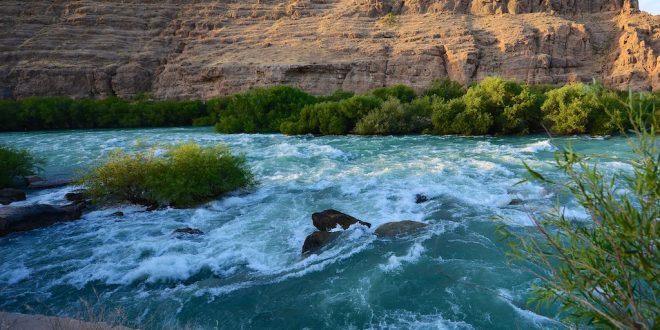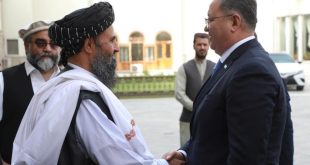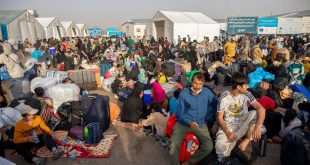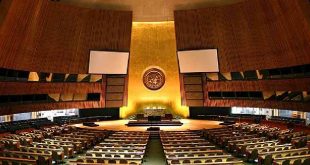By NAJIBULLAH LOODIN
The neighboring countries except China are highly dependent on water resources which originates in the high mountains of Afghanistan (Shroder & Ahmadzai, 2016). According to Thomas and Varzi (2015), ninety percent of the surface water flowing through Afghanistan is transboundary water. Four out of five major river basins in Afghanistan (Helmand, Harirud-Murghab, Amu Darya, and Kabul-Indus) are shared with neighboring countries. With the length of approximately 1300 kilometers, Helmand River Basin, which constitutes more than 40% of the surface water, is shared between Iran and Afghanistan (Shroder & Ahamdzai, 2016; Aman, 2016).
Dispute over water allocation between Iran and Afghanistan dates back to the 1870s, when Afghanistan was ruled by the British Empire. A British officer drew the Afghan-Iran border line along the main channel of Helmand River. In 1939, the king of Iran, Reza Shah Pahlavi, and Zahir Shah, the king of Afghanistan signed an agreement on sharing the Helmand River’s water, but it was not ratified by Afghan government. A decade later, in 1948, with the mediation of USA a trilateral committee was formed to assess the water rights of the two riparian countries of Helmand River Basin. On February, 1951, the Helmand River Delta Commission (HRDC) presented its findings. According to the commission, Iran’s water right from Helmand River Basin was amounted to be 22 cubic meters per second (Aman, 2016; Thomas & Varzi, 2015; Report of the Helmand River Delta Commission [RHRDC], 1951). However, the report of HRDC was rejected by Iran and instead asked for more water share from Helmand River Basin. Afghanistan, on the other side, suggested to provide extra 4 cubic meters of water per second to Iran provided that Iran allows Afghanistan to get access to the Bandar Abbas and Chabahar ports. In 1973, the transboundary water sharing agreement was signed by the Prime Minister of Afghanistan, Mohammad Musa Shafiq and his counterpart, Mir Abbas Hoveida, the Prime Minister of Iran (Aman, 2016; Goes et al., 2015; Shroder & Ahmadzai, 2016; Thomas & Varzi, 2015).
The forty-year devastating civil war (1979 onward) has destroyed the water infrastructures in Afghanistan. Shroder and Ahmadzai (2016) contend that during forty years of war and instability, Afghanistan has lost tremendous opportunities whilst its neighboring countries took advantages from Afghanistan’s long term instability by constructing hydro-power dams and irrigation structures. None of the neighboring countries consulted with Afghanistan regarding the construction of water infrastructural projects within their countries.
After the invasion of Afghanistan by US-led NATO forces late 2001, the Afghan government restructured its political presence in both regional and international arenas. As a ‘late developer’ the government of Afghanistan- Hamid Karzai (2001-2014), and Ashraf Ghani (2014-Present) – is committed to building up twenty one dams across the country (Aman, 2016). The purpose of constructing dams across the country is to irrigate agricultural lands, generate hydro-electricity and to control massive flooding. Constructing dams in the upstream state will severely affect the water availability in the downstream state. Meanwhile, the government of Afghanistan started the ‘third phase’ of Kamal Khan Dam on the lower Helmand River in Nimroz province. Afghan economic analysts believe that the completion of Kamal Khan Dam will play a significant role in the drought-struck southwest of the country (Tolo News, May 30, 2018).
The construction of Kamal Khan Dam has been criticized by the Iranian officials. For example, in October 2015, Mohammad Jawad Zarif, the Foreign Minister of Islamic Republic of Iran, stated that Kamal Khan Dam will intensely affect Iran’s water share (26 cubic meters per second). However, Zarif’s statement was rejected by officials in Ministry of Energy and Water of Afghanistan. Basir Azimi, spokesman to the Ministry of Energy and Water of Afghanistan contends that the completion of the ‘third phase’ of the Kamal Khan Dam will solve Afghan-Iran water dispute. He further added that the completion of Kamal Khan Dam will be a win-win game where Iran will gain its water sharing rights and Afghanistan will manage its water resources (cited in Aman, 2016).
Thomas and Varzi (2015) found out that the ongoing dam construction projects in the upstream of Helmand River Basin has deteriorated the ecosystem of the hamouns (lakes) within Afghanistan and Iran. Currently there are three Hamouns within Helmand River Basin. Hamoun-e- Puzak located within Afghanistan territory where Hamoun-e Saberi and Hamoun-e- Hirmand are situated in the downstream Iran. The destructive floods in 1989 and 1993 and the climate change induced drought in 2000 and 2005 have turned the hamouns into deserts. For nearly 55% of the rural population in Seistan-Baluchistan Province of Iran who deeply rely on agriculture, wetlands (hamouns) were the main source of freshwater for their livelihood (Shirdeli, 2014). The disappearance of hamouns has created unemployment forcing people to leave 124 villages in Seistan Baluchistan province (Thomas & Varzi, 2015).
On the other side, the military presence of US-led NATO forces in Afghanistan along with the constraints in foreign policy of Iran has pushed Afghanistan to unilaterally maintain control over water by constructing Kajaki, Kamal Khan and Bakhshabad Dams in the upstream of Helmand River Basin. Iranian officials continuously blame Afghan government for politicizing water resources while the Afghan officials rejecting that (Aman, 2016). Thomas and Warner (2015) argue that, as an upstream state, Afghanistan plays a hydro-hegemonic role in both Helmand and Harirud-Murghab River Basins. They argue that Afghanistan plays a negative/dominative hydro-hegemonic role by taking control over water in the upstream of Helmand River Basin resulting in not allocating Iran’s water share (see also, Zeitoun & Warner, 2006). On the other hand, according to Shroder and Ahmadzai (2016), the government of Afghanistan has banned any ministry to discuss over transboundary water management. Discussion on transboundary water of Afghanistan can be held upon approval by the National Security Council which is chaired by the president of Afghanistan. Lack of capacity building in hydro-cognizant, high regional asymmetrical power relations, distrust and lack of political will have prevented the Afghan government from discussing transboundary water management with tis neighboring states.
In a highly politicized river basin where Iran threatens to expel more than three million refugees from Iran while, as a counteraction, the Afghan government uses water as a tool to pressures Iran to treat Afghans in humanistic way, both of the countries should work on strategies to de-escalate the tension between riparian states through the lens of social-constructivism. The author of this paper believes that developing regional cooperative mechanisms for mitigation of transboundary water conflict in Helmand River Basin is only possible through engaging all stakeholders specifically the public.
To sum up, ‘strengthening policy and regulation, supporting long-term national and regional programs, evaluating basin-wide development alternatives and broadening areas of interaction and joint interest’ will help strengthen the transboundary water cooperation between Iran and Afghanistan.
 Afghanistan Times
Afghanistan Times




